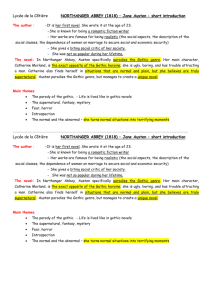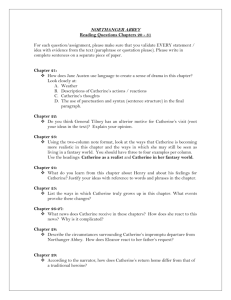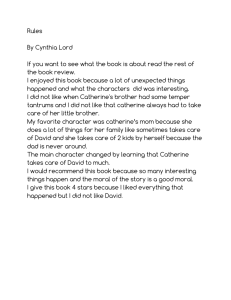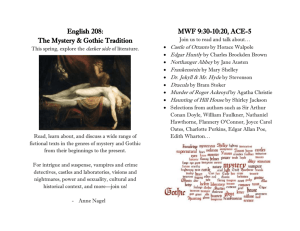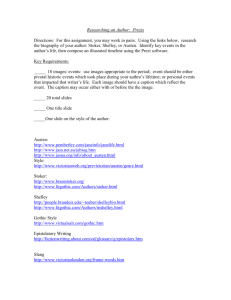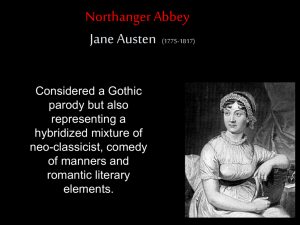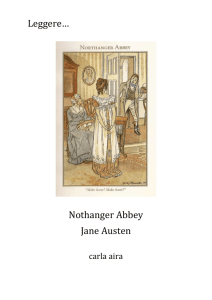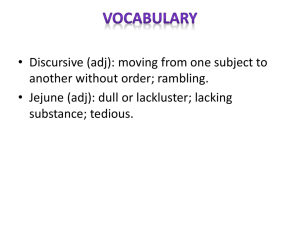northanger abbey & the gothic
advertisement
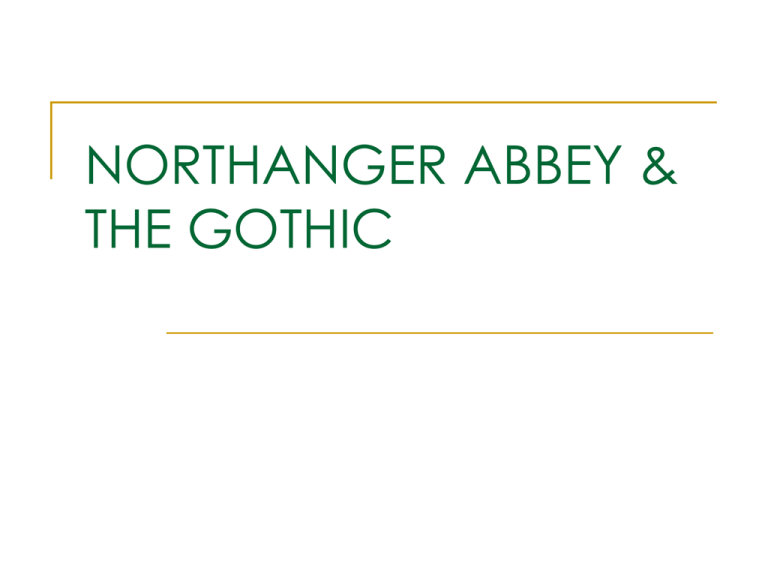
NORTHANGER ABBEY & THE GOTHIC The Gothic Old building in antique style/ gothic windows Innocent heroine Villain Hero whose identity/integrity is doubted Ruins Ghost/ monk-like figure Mystery The Gothic Storm Strange noises Sliding panel Dark atmosphere Missing document Servant, preferably with a secret Staircase, preferably winding Romance Story of adventure and love 16th & 17th centuries = representation of life a cynical one. Witty and critical with an ornate classical & rhetorical style 2nd ½ 18thC – rejection of this and looking for a more natural approach How does she do it? Ridicules romantic fiction by offering models of what is expected of a heroine, and denying Catherine these qualities Wit – paradox, antithesis, epigram & pun Irony – dramatic, verbal & socratic Satire Dialogue Voice & viewpoint Mood Sentence construction Northanger Abbey “Jane Austen exhibits the contrast between the world as it is and the world as imagined by the romancers whom she wishes to ridicule. She expresses it by the contrast between a normal, healthy-natured girl and the romantic heroines of fiction and by showing the girl slightly affected with romantic notions” Gothic Elements in Northanger Abbey The Gothic elements occur mostly in the second half of the novel, when Catherine goes to Northanger – eg, Henry’s storytelling and Catherine’s first night at the Abbey (look at the language that is used) Austen gently mocks this as the danger is not real, only perceived by Catherine who wants the situation to be horrifying. Setting Catherine imagines the abbey as an old building full of ancient legends “Its long damp passage, its narrow cells and ruined chapel, were to be within her daily reach, and she could not subdue the hope of some traditional legends, some awful memorials of an injured, ill-fated nun” We later see that her imaginings make the abbey more mysterious than it really is. Her expectations (in part supported by Henry’s story), clash with what she sees and this disappoints her. She wants to experience something similar to what her heroines do, but Northanger is a common building. Catherine’s Imagination The mysterious cabinet and manuscripts – look at the language Austen uses (chapter 21-22) Catherine imagines that General Tilney as firstly, killed his wife, then she imagines that he is keeping her prisoner in the Abbey. “ the probability that Mrs Tilney yet lived, shut up for causes unknown and receivint from the pitiliess hands of her husband a nightly supply of coarse food, was the conclusion that necessarily followed” Catherine’s Imagination When she investigates Mrs Tilney’s room, she is caught and scolded by Henry: “ Dearest Miss Morland, what ideas have you been admitting?” It is then that Catherine is able to recognise the influence of reading novels like The Mysteries of Udolpho Irony Dramatic irony = situation is apparent to the reader, but not to the character (laundry list) Verbal irony = words used in an opposite manner to their literal meaning (‘the delicacy, discretion, originality of thought, and literary taste which marked the reasonableness of that attachment’). Use of negatives: ‘without’ ‘never’ ‘instead of’ Socratic irony = adopts a character’s viewpoint to ridicule them – shows us her characters foibles (dialogue of Isabella, Thorpe & Mrs Allen reported second hand as so tedious) Dialogue Direct speech Indirect speech Interior dialogue Satire Ridiculing of faults of human nature - Result of irony Primary focus here is Gothic and romance literature – the misuse of it Sharpest satire is at the expense of the Thorpes Voice and Viewpoint Omniscient Interior dialogue – Catherine’s point of view Austen’s own voice Sentence Construction Length & construction is important Action & events = short sentences Elaborate construction of the period, with many dependent and linked clauses Purpose? Reading novels causes foolish imagination in the reader and leads to all sorts of dangers Reading novels is alright as long as the reader doesn’t mistake them for real life Its not necessary to find danger in novels, there’s plenty in real life Purpose? Is she ridiculing society in Bath and elsewhere Is she preaching about the dangers of society? Is she having fun with her readers to entertain them? Purpose? It is important to note that Austen parodies the Gothic novels of her time by using some of their techniques. In doing this she contrasts vivid imagination and common reality. Parody is based on Catherine’s mistakes – she suspects her host of a horrible act which is created in her own fantasy. Romanticism ? How does her purpose relate to the concerns of the module? Valuing the imagination, the individual & idealism Search for meaning through relationship with the natural world & wider social/political contexts Examine or affirm the power of the imagination to inform, illuminate and transform human experience Experimentation with ideas & forms may reflect or challenge ways of thinking
